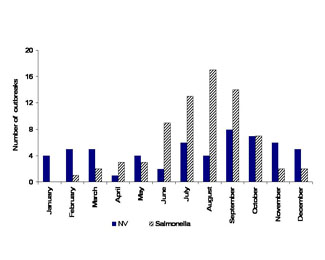Noroviruses hyperesistance

Acute gastroenteritis (AGE), often related to noroviruses, is one of the most common diseases suffered by the population. Noroviruses affect the stomach and intestines and are easily transmissible through human contact or in enclosed spaces, which would explain why they appear relatively frequently during cruise trips. This group of viruses stands out for its ability to resist good hygiene habits or extreme environments and is one of the main causes of gastrointestinal diseases. The following article presents a comparative study of the index of Salmonella and norovirus cases in Catalonia over a twelve month period. The results show that there is a higher incidence of norovirus attacks and a clear predisposition to cause epidemics when compared to other infectious agencies. Researchers thus propose establishing more exhaustive hygiene measures and that special attention be given to those who always suffer the most: the elderly and children.
Norovirus have become a well known cause of acute gastroenetritis (GE) affecting many people at a time in different settings and closed environments such as cruise ships, but they are also a relevant cause of foodborne outbreaks and of person- to person transmission in hospitals, nursing homes, schools and summer camps.
The resistance of norovirus to enviromental adverse conditions such as extreme temperatures and clorine makes them quite difficult to get rid of even when foodhandlers do follow good higiene practices in the preparation of foods and good cleaning habits are followed. Norovirus cause diarrea but vomiting is one of the clinical features that characterize this infection. The aerosols formed during vomitting is thought to be one of the main causes for the spread of the infection by contamination of floors and surfaces.
Efforts to promote hygiene at community level as well as a family-centred approach are important to ensure a better understanding of the mechanisms of spread and prevention of infection. This article compares norovirus outbreaks occurred in Catalonia during one year, with Salmonella, being the latter a widely recognized pathogen to cause gastroenteritis mainly through ingestion of contaminated food stuffs, the data show that norovirus has a higher attack rate ending up in larger outbreaks than other infectious agents (Table 2).
Distributrion of outbreaks throughout the year did not present any seasonal pattern whereas Salmonella outbreaks distictly are more frequent in the warmer months. The amount of population affected (incidence rates per 100,000 people/year) is also higher for norovirus. This information highlights the relevance of norovirus as a main cause of gastrointestinal disease, especially in the elderly and young children.
References
Acute gastroenteritis outbreaks in Catalonia, Spain: Norovirus versus Salmonella. Torner, N; Dominguez, A; Ruiz, L; Martinez, A; Bartolome, R; Buesa, J; Ferrer, MD. SCANDINAVIAN JOURNAL OF GASTROENTEROLOGY, 43 (5): 567-573 MAY 2008


